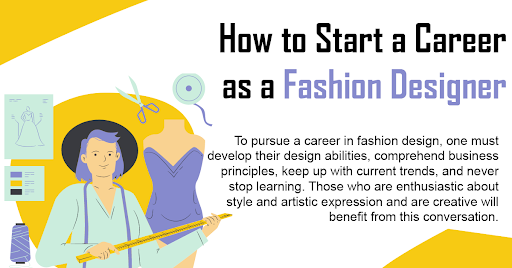How to Start a Career as a Fashion Designer

To pursue a career in fashion design, one must develop their design abilities, comprehend business principles, keep up with current trends, and never stop learning. According to Karolina Zmarlak, those who are enthusiastic about style and artistic expression and are creative will benefit from this conversation. Talent development, education, experience, and networking are among the crucial steps that are outlined. A combination of these elements are necessary for a successful career in fashion design.
Enhance your abilities and understanding
Commence by studying the fundamentals of fashion design, such as fabric knowledge, sewing, pattern making, and sketching. To receive formal education, enrol in fashion design courses or earn a degree from a reputable fashion institution. Karolina Zmarlak asserts that by routinely reading fashion magazines, going to fashion shows, and keeping up with well-known designers, you can stay informed about both historical and contemporary fashion trends.
Gain experience through internships and entry-level positions
Internships and entry-level positions offer practical insights into the workings of the fashion world. Apply your skills in real-world settings, understand the day-to-day operations of fashion businesses, and learn from established professionals. Start by interning with fashion houses, designers, or retail brands. Entry-level positions, such as assistant designer or fashion illustrator, help you build your portfolio and resume.
Develop a powerful portfolio
Build a strong portfolio that showcases your individuality, inventiveness, and level of technical skill. To show off your versatility, include sketches, finished clothing, and conceptual designs. Emphasize specific assignments, like creating a Techno Jacket, to demonstrate your creative thinking. Update your portfolio often, and if you want to reach more people, think about making an online version.
Make connections in the industry and network
Attend trade shows, fashion shows, and networking mixers to build relationships with professionals in the industry. Connect with colleagues and stay up to date on industry news by joining online communities and fashion design associations. Make use of social media sites like LinkedIn and Instagram to promote your work and establish connections with influential people in the industry. Developing a strong professional network can open doors to job offers, mentoring relationships, and insightful information.
Keep abreast of technological and fashion trends
Trends and technological advancements bring about constant changes in fashion. Keeping up with current trends is essential for success in the fashion design industry. Watch runway shows, read trade magazines, and keep up with fashion blogs. Play with different materials and design strategies. From digital sketching tools to 3D printing, technology is playing a bigger role in the fashion industry. Innovation and flexibility are demonstrated by the inclusion of components like convertible fashion. Using technology into your designs can help them become more marketable in the current environment.
Start a clothing line or business of your own
After you have accumulated enough experience and developed a solid portfolio, think about starting your own fashion label or business. Write a business plan that includes the target market, marketing strategies, financial projections, and the vision of your brand. To make your designs a reality, source high-quality materials and locate trustworthy manufacturers. A distinctive logo, branding materials, and a unified design aesthetic can help you establish a powerful brand identity.
Promote your designs efficiently
To reach your target audience, make use of both traditional and digital marketing techniques. Invest in a professional website and keep your social media profiles updated to establish a powerful online presence. Increase your audience reach by partnering with bloggers and fashion influencers. Take part in pop-up events, trade shows, and fashion weeks to increase visibility.
Oversee fashion design's business facets
It is imperative to comprehend business fundamentals like pricing, inventory management, budgeting, and sales tactics. Develop these abilities by working with a business mentor or enrolling in business management courses. Manage your operations and finances effectively to guarantee sustainability and profitability. To safeguard your business interests and intellectual property, be aware of legal issues pertaining to contracts, trademarks, and copyrights.
Always seek to innovate and improve
Ask for feedback from customers, mentors, and peers on a regular basis. Remain observant and receptive to novel concepts, methods, and fashions. Try out various textures, patterns, and technological advancements to maintain the originality and creativity of your work. Participate in courses, seminars, and workshops to advance your knowledge and abilities. For your business to stay relevant and competitive, you must be flexible and willing to change with it.
Ask for advice and mentoring
Seek out seasoned experts who can serve as mentors by sharing their experiences and providing advice. To make connections with possible mentors, join networks and professional organizations. As your career develops, keep an open mind about mentoring others. In the fashion industry, creating a community of support encourages development, education, and cooperation.
Conclusion
Pursuing a profession in fashion design demands commitment, enthusiasm, and a calculated approach. Karolina Zmarlak concluded that you may establish a strong foundation and create a fulfilling career in the rapidly changing fashion industry by adhering to these guidelines.